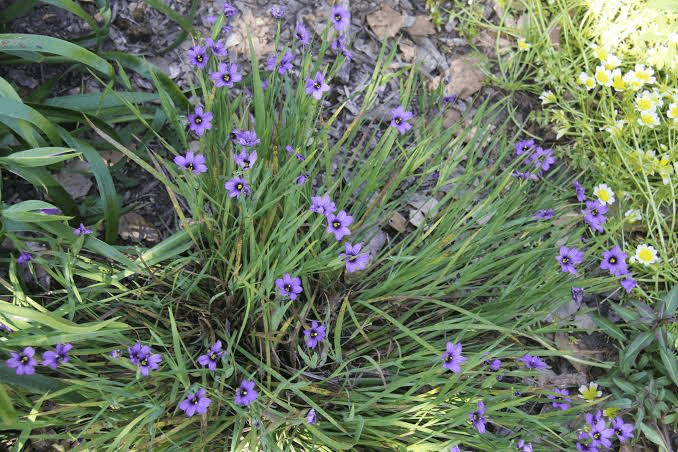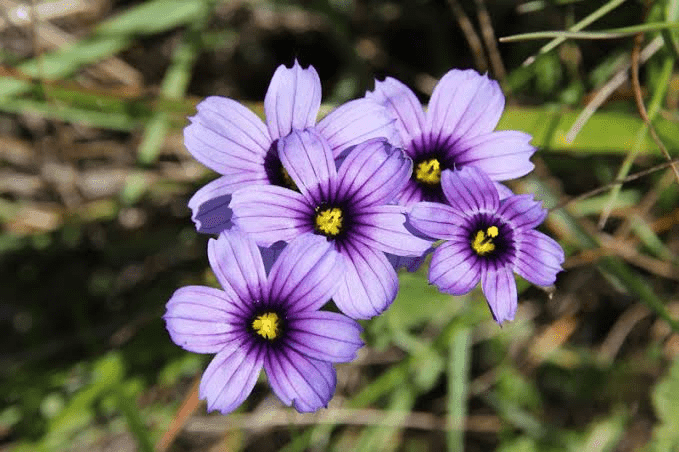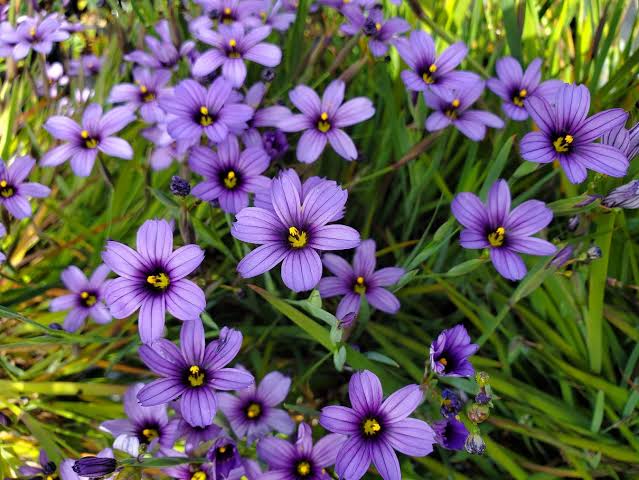Sisyrinchium bellum, commonly known as Blue-Eyed Grass, is a charming perennial plant that graces the wild landscapes of North America, particularly the western regions. This petite marvel belongs to the iris family, Iridaceae, and captivates with its delicate appearance and vivid blue-purple flowers.
Despite its name, Blue-Eyed Grass isn’t a grass but a member of the iris family, showcasing slender, grass-like leaves that create an elegant backdrop for its striking blooms. Standing at around 6 to 18 inches tall, this perennial beauty is a favorite among wildflower enthusiasts and gardeners alike, adding a touch of natural elegance to gardens, meadows, and woodland edges.
Blue-Eyed Grass is renowned for its enchanting blooms, which typically appear in late spring to early summer. Each flower features vibrant blue to violet petals, delicately arranged around a golden-yellow center, resembling a mesmerizing eye.
These blossoms, often no more than an inch in diameter, are not just a visual delight but also play a vital role in supporting local pollinators, including bees and butterflies. Its ecological significance extends to providing nectar and habitat, contributing to the biodiversity of the areas it inhabits.
This resilient perennial can be found in a variety of habitats, from coastal cliffs and grasslands to open woodlands and meadows. Blue-Eyed Grass is adaptable, thriving in both sunny and partially shaded environments. Its preference for well-drained soils makes it a common sight in sandy or loamy substrates.
In the wild, it often graces the slopes of hillsides and the edges of forests, contributing to the overall beauty of natural landscapes. Its adaptability and natural allure make it a symbol of the untamed beauty found in the wild corners of North America.
Beyond its ecological importance, Blue-Eyed Grass holds cultural and symbolic significance. In some Native American traditions, the plant is associated with vision, clarity, and insight, owing to its vibrant eye-like blooms. Its presence in folklore and indigenous ceremonies emphasizes its revered status, further enhancing its appeal.
Additionally, gardeners appreciate its ornamental value, incorporating it into garden designs to evoke a sense of natural charm and sophistication. Sisyrinchium bellum, with its ethereal blossoms and multifaceted significance, stands as a testament to the intricate wonders of the natural world and continues to captivate admirers across various landscapes.
Botanical Description of Sisyrinchium bellum
Sisyrinchium bellum, commonly known as Blue-Eyed Grass, is a perennial herbaceous plant that belongs to the Iris family, Iridaceae. This enchanting wildflower is native to California and can be found in various regions of North America. Let’s delve into the botanical description of this charming plant.
1. Life: Blue-Eyed Grass is a herbaceous perennial, which means it lives for more than two years and typically remains evergreen, adding a touch of color to the landscape year-round.
2. Size: The plant is relatively small, usually ranging from 4 to 15 inches (10 to 38 cm) in height. Its compact size makes it a perfect addition to gardens, especially in the front or border areas.
3. Leaves: Blue-Eyed Grass features slender, grass-like leaves that are often mistaken for actual grass blades. These leaves are linear and grow in a basal rosette form, meaning they form a circular arrangement at the plant’s base.
4. Flowers: The most captivating feature of Blue-Eyed Grass is its delicate, star-shaped flowers. These striking blooms come in various shades of blue and violet, although you may also encounter white or yellow varieties. Each flower has a bright yellow center, which is the source of its common name, “Blue-Eyed Grass.”
5. Growth Pattern: The plant has a clumping growth habit, meaning it forms clusters of individual plants. This creates a visually appealing effect in natural settings and gardens.
6. Root System: Blue-Eyed Grass develops a fibrous root system that helps it anchor firmly in the ground. This system also allows it to tolerate drought conditions.
7. Flowering Season: Blue-Eyed Grass typically blooms in the spring and early summer, creating a delightful display of color. The flowers open in the morning and close in the afternoon, which adds to their charm.
8. Pollinators: The vibrant flowers of Blue-Eyed Grass attract a variety of pollinators, including bees and butterflies. These insects play a crucial role in the plant’s reproduction by facilitating cross-pollination.
9. Native Range: Blue-Eyed Grass is native to California and can be found in many parts of North America, from Oregon to Baja California. It thrives in a range of habitats, from open meadows to woodlands and coastal areas.
10. Medicinal and Cultural Significance: While Blue-Eyed Grass is primarily valued for its ornamental beauty, some indigenous cultures have used it for medicinal purposes. It is important to note that its medicinal uses are not widely recognized, and any such applications should be undertaken with caution and expert guidance.
The botanical description of Sisyrinchium bellum provides insight into the plant’s unique characteristics, from its slender grass-like leaves to its striking star-shaped flowers. This perennial herbaceous beauty, native to California, adds a touch of elegance to natural landscapes and gardens while also captivating pollinators with its vibrant blooms. Its compact size and clumping growth habit make it a delightful addition to various outdoor settings.
The Geographic Distribution of Sisyrinchium bellum (Blue-Eyed Grass)
1. Native Habitat: Blue-Eyed Grass, scientifically known as Sisyrinchium bellum, is predominantly native to the western regions of North America, particularly in California. Its natural habitat includes grasslands, meadows, and open woodlands. This beautiful wildflower can also be found in regions of Oregon and Baja California.
2. Growing Conditions: Blue-Eyed Grass thrives in areas with well-drained soil and a good amount of sunlight. It is well adapted to the dry, Mediterranean climate of California. The plant often grows in clusters, creating picturesque displays in natural landscapes.
3. Cultivation: While Blue-Eyed Grass is commonly found in the wild, it is also cultivated in gardens and landscapes for its aesthetic appeal. Gardeners appreciate its ability to add color to rock gardens, borders, and perennial beds. Cultivating Blue-Eyed Grass in gardens outside its native range allows enthusiasts to enjoy its beauty in various parts of the world.
The Chemical Composition of Sisyrinchium bellum (Blue-Eyed Grass)
1. Alkaloids: Blue-Eyed Grass contains alkaloids, which are naturally occurring chemical compounds. Alkaloids often have physiological effects on humans and animals, although the specific alkaloids in Blue-Eyed Grass and their effects are not extensively studied.
2. Flavonoids: Flavonoids are secondary metabolites found in various plants, including Blue-Eyed Grass. These compounds have antioxidant properties and contribute to the plant’s vibrant colors. Flavonoids play a role in protecting the plant from oxidative stress.
3. Terpenoids: Terpenoids are organic compounds derived from terpenes. They have diverse biological activities and are often involved in the plant’s defense mechanisms. While the specific terpenoids in Blue-Eyed Grass haven’t been widely studied, their presence contributes to the plant’s overall chemical composition.
The Harvesting and Processing of Sisyrinchium bellum (Blue-Eyed Grass)
1. Harvesting: Blue-Eyed Grass is typically harvested in the wild for ornamental purposes. Gardeners may also harvest seeds from cultivated plants. The harvesting process involves carefully cutting the plant at the base to preserve its roots for regrowth.
2. Drying: When harvesting Blue-Eyed Grass for ornamental use, it’s essential to dry the plant properly. This is usually done by hanging the harvested plants upside down in a well-ventilated area. Drying preserves the plant’s vibrant color and ensures it can be used for decorative purposes.
3. Processing: In traditional medicinal practices, parts of Blue-Eyed Grass have been used, though modern applications are limited due to the lack of extensive research. Any processing for medicinal use would involve extracting active compounds from the plant material, following appropriate protocols to maintain safety and efficacy.
Blue-Eyed Grass, with its charming blue-violet flowers and slender leaves, occupies specific geographic regions in North America. Its chemical composition, though not extensively studied, includes alkaloids, flavonoids, and terpenoids. The plant is harvested for ornamental purposes, and while it has historical uses in traditional medicine, its contemporary applications are limited. Understanding its geographic distribution, chemical composition, and processing methods provides valuable insights into this delightful wildflower.
Read Also: Layers Mash Feed Formula
The Medicinal Health Benefits Of Sisyrinchium bellum (Blue-Eyed Grass)

Sisyrinchium bellum, commonly known as Blue-Eyed Grass, has a unique charm that extends beyond its ornamental value. While it is not widely recognized for its medicinal applications, it has been used in traditional herbal medicine for its potential health benefits. Here are some of the medicinal health benefits associated with Blue-Eyed Grass:
1. Anti-Inflammatory Properties: Blue-Eyed Grass has been used traditionally for its potential anti-inflammatory properties. Infusions or poultices made from the plant have been applied topically to soothe skin irritations and reduce inflammation.
2. Analgesic Effects: Some traditional remedies suggest that Blue-Eyed Grass may have mild analgesic (pain-relieving) effects. It has been used in herbal preparations to alleviate minor aches and pains.
3. Relaxing Qualities: In traditional herbal practices, Blue-Eyed Grass has been used for its calming and relaxing properties. Infusions or teas made from the plant have been consumed to promote a sense of relaxation.
4. Digestive Support: Blue-Eyed Grass has been associated with potential digestive benefits. It has been used to ease mild gastrointestinal discomfort, such as indigestion.
5. Mild Sedative: Some traditional uses of Blue-Eyed Grass suggest that it may have mild sedative effects, which can help with conditions like anxiety and restlessness.
6. Eye Health: Blue-Eyed Grass has been historically used for maintaining eye health. It is believed to help with minor eye irritations and discomfort.
The Methods of Usage to Achieve the Provided Health Benefits Of Sisyrinchium bellum (Blue-Eyed Grass)
While Blue-Eyed Grass has been traditionally used for its potential health benefits, it’s important to note that modern scientific research on these claims is limited. Nevertheless, here are some traditional methods of usage to potentially achieve the provided health benefits:
1. Topical Applications: For skin irritations and inflammation, Blue-Eyed Grass poultices or compresses have been applied topically. The plant material is crushed and mixed with a suitable carrier before application.
2. Herbal Infusions: To promote relaxation or address digestive discomfort, Blue-Eyed Grass has been used to prepare herbal infusions or teas. The plant material is steeped in hot water and consumed.
3. Tinctures: Blue-Eyed Grass tinctures have been made by soaking the plant in alcohol or another suitable solvent. These tinctures are used in small, controlled doses.
4. Eye Wash: For minor eye issues, a diluted Blue-Eyed Grass infusion has been used as an eye wash. This should only be done with great care and under the guidance of a healthcare professional.
The Side Effects Of Using Sisyrinchium bellum Medicinal Plant
Blue-Eyed Grass is generally considered safe when used in accordance with traditional practices. However, it’s essential to be aware of potential side effects or precautions:
1. Allergic Reactions: Some individuals may be sensitive or allergic to Blue-Eyed Grass. It’s recommended to perform a patch test before applying it to the skin.
2. Dosage: Excessive consumption of Blue-Eyed Grass or using it in large quantities may lead to adverse effects. Always follow recommended dosages.
3. Interaction with Medications: If you are taking medications or have underlying health conditions, consult a healthcare professional before using Blue-Eyed Grass for medicinal purposes. It may interact with certain medications.
4. Eye Use: When using Blue-Eyed Grass for eye-related issues, extreme caution should be exercised. Any eye treatment should be supervised by a qualified eye care professional.
It’s important to approach the medicinal use of Blue-Eyed Grass with care and seek guidance from a healthcare professional or herbalist, especially if you have specific health concerns or are considering its use in significant quantities. Additionally, more research is needed to substantiate its traditional medicinal claims.
Read Also: 10 Medicinal Health Benefits Of Myrica caroliniensis (Southern Bayberry)
The Scientific Research and Studies of Sisyrinchium bellum (Blue-Eyed Grass)

Scientific research on Sisyrinchium bellum, or Blue-Eyed Grass, has been limited, and it is primarily known for its ornamental qualities rather than its medicinal potential. Nevertheless, a few studies and observations have shed some light on this plant:
1. Botanical Studies: Several botanical studies have focused on the morphology and distribution of Blue-Eyed Grass. These studies help identify the plant’s characteristics, growth patterns, and ecological preferences.
2. Ecological Research: Research has been conducted to understand the role of Blue-Eyed Grass in various ecosystems. This includes its interactions with pollinators and its contribution to biodiversity.
3. Ethnobotanical Research: Some ethnobotanical studies have explored the traditional uses of Blue-Eyed Grass by indigenous communities. These studies provide insights into its historical applications, especially in relation to minor ailments and skin conditions.
However, it’s essential to note that in the context of modern scientific medicine, Blue-Eyed Grass remains largely unexplored. Its potential health benefits require further investigation, and its traditional uses should be approached with caution until more comprehensive research is available.
The Safety Precautions and Recommendations In Using Sisyrinchium bellum (Blue-Eyed Grass) Medicinal Plant
When considering the use of Blue-Eyed Grass for its potential health benefits, it’s crucial to take safety precautions and follow recommendations:
1. Allergy Test: Perform an allergy test before applying Blue-Eyed Grass topically. Apply a small amount to a small area of skin and wait for any adverse reactions. If irritation occurs, discontinue use.
2. Consult a Professional: If you have underlying health conditions or are taking medications, consult a healthcare professional or herbalist before using Blue-Eyed Grass for medicinal purposes. It may interact with certain medications.
3. Dosage: Follow recommended dosages when using Blue-Eyed Grass in herbal preparations. Excessive consumption may lead to adverse effects.
4. Eye Use: Extreme caution should be exercised when using Blue-Eyed Grass for eye-related issues. Consult a qualified eye care professional and follow their guidance.
FAQs About Sisyrinchium bellum (Blue-Eyed Grass) Medicinal Plant
Q1: Is Blue-Eyed Grass safe for all skin types?
A1: While Blue-Eyed Grass is generally considered safe, it’s essential to perform an allergy test before applying it to your skin, especially if you have sensitive skin.
Q2: Can Blue-Eyed Grass be ingested for its potential health benefits?
A2: Blue-Eyed Grass has been used in herbal infusions, but it’s crucial to follow recommended dosages and consult a healthcare professional, especially if you have underlying health conditions.
Q3: Is Blue-Eyed Grass effective for reducing inflammation?
A3: While it has been used traditionally for its potential anti-inflammatory properties, scientific research is limited. Individual responses may vary.
Q4: Are there any known drug interactions with Blue-Eyed Grass?
A4: Blue-Eyed Grass may interact with certain medications, so consult a healthcare professional if you are taking any medications.
Q5: Can I use Blue-Eyed Grass for eye irritations without professional guidance?
A5: It’s strongly recommended to consult a qualified eye care professional before using any plant-based remedies for eye issues.
The information provided here is based on available knowledge, but it’s crucial to exercise caution, seek professional advice, and monitor your individual response when considering the use of Blue-Eyed Grass for medicinal purposes. Scientific research on this plant is ongoing, and further findings may influence its safety and recommended applications.
Read Also: Best Yard Waste Removal Methods

